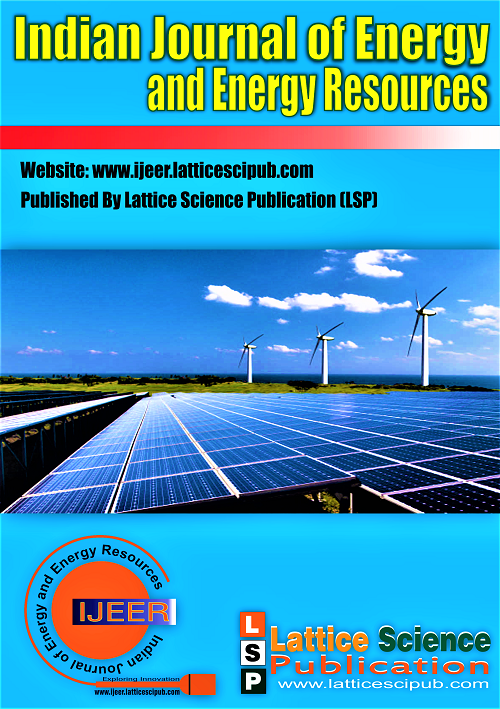Efficiency Improvement and Comparative Studies of Solar Organic Rankine Systems using Nanofluids
Main Article Content
Abstract
Solar power generation has emerged as one of the most rapidly growing sources of renewable energy. The solar thermal system with a Rankine cycle used to harness solar energy and generate electricity from a low-temperature heat source is an emerging technology. The major drawback of solar thermal power generation is its poor efficiency, which is around 10% to 15%. Although prior attempts to improve the efficiency of the solar thermal system and use of Nano fluids in heat transfer applications have been carried out, very little work has been carried out using Nano fluids in Rankine cycle systems. Thus, the objective of the research undertaken was to primarily improve the efficiency of a small-scale solar thermal system by selecting working fluids, optimizing the system parameters and using Nano fluids with improved heat transfer properties for capturing heat. Thermodynamic simulation tool Aspen Hysys was used to carry out simulations of the Rankine and Regenerative Rankine systems. The system was simulated with combinations of Dowtherm-Cu O/Ag/Al2O3/TiO2 as the heat transfer fluid, and n-butane, n-pentane, n-hexane, or R-134a as the working fluid. System parameters such as mass flow, temperature, and pressure were optimized to obtain maximum power output and efficiency, keeping the system constraints and practicality in mind. The use of Nano fluids improved heat transfer to the working fluid in the heat exchanger by a maximum of 50%. The efficiency of the basic Rankine cycle was determined 16.03% for n-pentane, 14.90% for n-hexane, 13.83% for n-butane, and 9.82% for R-134a as the working fluid. Further, the use of regeneration improved the efficiency of the system by 6%, 3 %, 7% and 2% respectively. Highest efficiency of 27.96% was obtained when 6% volume concentration of Al2O3 was used in the heat transfer fluid, and n-pentane was used as the working fluid in the Regenerative Rankine cycle.
Downloads
Article Details

This work is licensed under a Creative Commons Attribution-NonCommercial-NoDerivatives 4.0 International License.
How to Cite
References
Ministry of New and Renewable Energy, Government of India Annual
Report, 2020-21, pp.15-44. [CrossRef]
Quoilin, S., Broek, M.V.D., Declaye, S., Dewallef, P., Lemort, V.,
“Techno-economic survey of Organic Rankine Cycle (ORC) systems,
Journal of Renewable and Sustainable Energy Reviews, Vol.22, 2013,
pp.168-186.
Jamal, N., “Comparative studies and analyses of working fluids for
Organic Rankine Cycles – ORC”, KTH School of Industrial Engineering
and Management, 2012.
Sylvain, Q., “Techno-economic survey of Organic Rankine Cycle
(ORC) systems” Renewable and Sustainable Energy Reviews, Vol. 22,
, pp.168-186. [CrossRef]
Andrew, C.M., "Design & Optimization of Organic Rankine Cycle
Solar-Thermal Power plants", Master Thesis, University of Wisconsin –
Madison, 2006.
Cheng, E.C., Sanjayan V., Amer, N.D., “Solar Thermal Organic Rankine
Cycle As A Renewable Energy Option”, Jurnal Mekanikal, Vol. 20,
, pp.68-77.
Freeman, J., Hellgardt, K., Markides, C.N., “An assessment of solarpowered organic Rankine cycle systems for combined heating and
power in UK domestic applications”, Journal of Applied Energy,
Vol.138, 2015, pp.605-620. [CrossRef]
Kyoung, H.K., “Effects of Superheating on Thermodynamic
Performance of Organic Rankine Cycles”, World Academy of Science,
Engineering and Technology, Vol. 2, 2011, pp.32-38.
Eastman, J.A., Choi, S.U.S., Li,S., Yu,W., Thompson,L.J.,
“Anomalously increased effective thermal conductivities of ethylene
glycol-based nanofluids containing copper nanoparticles,” Applied
Physics Letters, Vol. 78, (6), 2011, pp. 718–720. [CrossRef]
Xuan, Y., Qiang, L., “Heat transfer enhancement of nanofluids”,
International Journal of Heat and Fluid Flow, Elsevier, Vol. 21, 2000,
pp.58-64. [CrossRef]
Wen, D., Lin, G., Vafaei, S., Zhang, K., “Review of nanofluids for heat
transfer applications”, Particuology, Elsevier, Vol. 7, 2009, pp-141-150.
[CrossRef]
Keblinski, P., "Mechanisms of heat flow in suspensions of nano-sized
particles (nanofluids)", International Journal of Heat and Mass Transfer,
Vol. 45, 2002, pp. 855-863. [CrossRef]
Eastman, J.A., "Anomalously increased effective thermal conductivities
of water based nano fluids containing copper nano-particles", Applied
Physics Letters, Vol. 14, 2001, pp.121-125.
Singh, A.K., "Thermal conductivity of nano fluids", Defence Science
Journal, Vol. 23, 2008, pp.345-369.
Sarit, K.D., "Temperature dependence of thermal conductivity
enhancement for nano fluids", Journal of Heat Transfer, Vol. 15, 2003,
pp.56-67.
Albadr, J., Satinder, T., Alasadi, M., “Heat transfer through heat
exchanger using Al2O3 nanofluid at different concentrations”, Case
Studies in Thermal Engineering, Vol. 1, 2013, pp. 38-44. [CrossRef]
Otanicar, T., “Nanofluid-Based Direct Absorption Solar Collector”,
Journal Of Renewable and Sustainable Energy, Vol. 2, 2010, pp.109-
[CrossRef]
Saadatfar, B., Fakhrai, R., Fransson, T., “Conceptual modeling of
nanofluid ORC for solar thermal polygeneration”, Energy Procedia,
Elsevier, Vol.57, 2013, pp.2696-2705. [CrossRef]
Xuan, Y., Roetzel, W., "Conceptions for heat transfer correlation of
nanofluids", International Journal of Heat and Mass Transfer, Vol.43,
, pp. 3701–3707. [CrossRef]
Yu, W., Choi, S.U.S, "The role of interfacial layering in the
enhancement of thermal conductivity of nanofluid: A renovated
Maxwell model", Journal of Nanoparticles Researches, Vol.5, 2003, pp.
-17. [CrossRef]
Duangthongsuk, W., Wongwises, S., "Heat transfer enhancement and
pressure drop characteristics of TiO2–water nanofluid in a double-tube
counter flow heat exchanger", International Journal of Heat and Mass
Transfer, Vol.52, 2009, pp. 2059-2065. [CrossRef]
Bönnemann, H., “Mono disperse copper and silver nano colloids
suitable for heat-conductive fluids,” Applied Organometallic Chemistry,
Vol. 19, (6), 2005, pp. 768–773. [CrossRef]
Abdel, E., Tora, H., “Nanofluids as a cooling agent for Rankine power
cycle”, 2nd International Conference on Energy systems and
Technologies, Egypt, 18-21 Feb.2013.
Pak, B.C., Cho, Y.I., "Hydrodynamic and heat transfer study of
dispersed fluids with submicron metallic oxide particles" Experimental
Heat Transfer, Vol.11, 1998, pp. 151–170. [CrossRef]
Drew, D.A., Passman, S.L., "Theory of multi component fluids",
Springer, Vol.3, 1999, pp. 156-162. [CrossRef]





